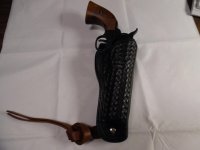rednichols
Member
Update on Tom Threepersons: It's now abundantly clear, after collecting five hundred references that have confirmed Jim Coffey's monograph on the subject, that not only were there two Tom Threepersons, but the lawman we know actually took the identity of the other. There was not 'confusion'; it was quite intentional.
The Tom Three Persons who won in Calgary in 1912, a Blood Indian living in Alberta (interestingly was considered a British citizen) and born 1889, was not the man who appeared at rodeo in Arizona in 1916 claiming to be that same Tom Three Persons born 1889; but as a Cherokee. The two-word spelling was not an accident. "Our" Tom immediately joined the U.S. Army as Thomas Three Persons (still two words) and was known by this spelling until he left the Army, at which point the El Paso City Directory lists him as Thomas Threepersons, blacksmith.
All of Tom's identity was taken from the Blood's: the name, NWMP service, time in Alberta, winning the Calgary Stampede, rancher, Indian; all of it. The Blood Indian lived until 1946 until, ironically, he died as a result of wounds in a small stampede of his own horses on his ranch in Alberta. "Our" Tom's accomplices: wife Lorene, a Cherokee writer who was his second wife after his first wife and mother of his only child (alsop Cherokee) died whilst Tom had her in Mexico on the Cudahay Ranch; Eugene Cunningham; and Oren Arnold, both men being accomplished writers and novelists. Lorene gave all of Tom's interviews; Oren Arnold called him "the taciturn Indian" and said that he had to interview Lorene to get his stories. Cunningham and Arnold likely never knew what happened to them! One story indicates that Tom served in Germany in WW1, when that is provably false.
Legend has it that Tom was a lawman throughout the 1920s who took occasional breaks for ranching. The reality is that he was a lawman at El Paso Police Department beginning 1920 who took breaks to serve with other agencies -- notably Treasury where his appointment was only for 3 months (served 6) and Customs -- until he was asked to resign from EPPD at the end of 1927. He never served as a lawman again, ranching in NM until his death in 1969. He sold his guns in December of 1929, likely because he needed the money: the Crash of '29 was on the last day of October that year. He sold his last gun, an SAA, the month after Lorene died in '68, took his third wife immediately after.
The holster legend? Absolutely true: the evidence is that he took his Egland holster, and his friend's Brill along with the friend (Ranger Trimble) to Sam Myres; and it was Myres' "Threepersons Style Holsters" that both saved Myres' company from failure after the Crash of '29, and launched the style that we all know and love to this very day. Lost in translation: the very functional internal welt structure that is not used today because it adds a level of difficulty to the build (certainly Myres and Brill knew about these welts, and it was Arno Brill himself who created Myres' Threepersons line for the 1931 launch). Why? Prudence: he needed money and Sam agreed to pay him a royalty; and it must have worked for both men because Tom was able to buy his TV Ranch in Grant county NM, and Sam was able to save his company (well documented events).
Did "our" Tom leave El Paso in part because the truth had caught up with him? Well, I've only been able to locate a single newpaper article about him as Cherokee, that repeated the legend into what we now call Canada; and that was in the late 1930s whilst Three Persons himself died in 1946. I doubt we'll ever know if the Blood Indian knew his identity had been expropriated (called "ghosting" and not uncommon circa 1900).
Update on his holster: I made the decision that the second series of Tom Threepersons' holster would be an Improved version. With the first I resisted any such temptation, because the series' purpose was to preserve the details of Tom's original in case the original never makes it back to USA.
This second one is everything the original could have been if they'd known then what we know now, about 'ideal'. His carry angle, and his drop, and his welt configuration that grips the SAA frame, remain unchanged; they were perfect 'as delivered'. The belt loop, though, has been sculpted at the grip to allow a clean grasp of the pistol and remove the stresses that twisted the grip inward and the hammer outward from the body. The tip of the belt loop has been re-sculpted to take the stress of the traditional "Myres" type loop used on his holster (tho it is not a Myres) using a method I created circa 1970: it changes the stress on the stitches from end-loaded (Tom's holster had been resewn at the corners) to side-loaded. That and nylon thread makes the structure extremely strong. Also added: full kangaroo lining (surprisingly similar leather to the half linings used on Brill and Sessums holsters), increased coverage of the cylinder, removable leg strap (original is riveted in place), and the welt stitching reconfigured to 'give witness' to Tom's unusually supportive welt. I say "Tom's" but likely it was the builder, believed to be Egland in Douglas AZ, who came up with it in response to the Brill of ten years earlier.
Apologies as usual, for the use of a Nichols (no relation) capgun in the holster; there are no guns here. This one, however, has been meticulously altered to match one of Tom's SAAs both dimensionally and cosmetically; note the odd modification to the rear sight.
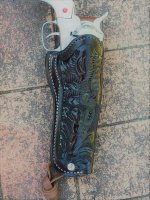
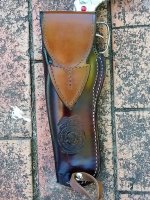
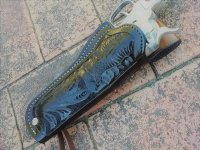
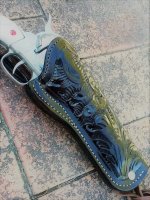
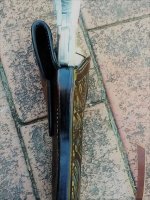
The Tom Three Persons who won in Calgary in 1912, a Blood Indian living in Alberta (interestingly was considered a British citizen) and born 1889, was not the man who appeared at rodeo in Arizona in 1916 claiming to be that same Tom Three Persons born 1889; but as a Cherokee. The two-word spelling was not an accident. "Our" Tom immediately joined the U.S. Army as Thomas Three Persons (still two words) and was known by this spelling until he left the Army, at which point the El Paso City Directory lists him as Thomas Threepersons, blacksmith.
All of Tom's identity was taken from the Blood's: the name, NWMP service, time in Alberta, winning the Calgary Stampede, rancher, Indian; all of it. The Blood Indian lived until 1946 until, ironically, he died as a result of wounds in a small stampede of his own horses on his ranch in Alberta. "Our" Tom's accomplices: wife Lorene, a Cherokee writer who was his second wife after his first wife and mother of his only child (alsop Cherokee) died whilst Tom had her in Mexico on the Cudahay Ranch; Eugene Cunningham; and Oren Arnold, both men being accomplished writers and novelists. Lorene gave all of Tom's interviews; Oren Arnold called him "the taciturn Indian" and said that he had to interview Lorene to get his stories. Cunningham and Arnold likely never knew what happened to them! One story indicates that Tom served in Germany in WW1, when that is provably false.
Legend has it that Tom was a lawman throughout the 1920s who took occasional breaks for ranching. The reality is that he was a lawman at El Paso Police Department beginning 1920 who took breaks to serve with other agencies -- notably Treasury where his appointment was only for 3 months (served 6) and Customs -- until he was asked to resign from EPPD at the end of 1927. He never served as a lawman again, ranching in NM until his death in 1969. He sold his guns in December of 1929, likely because he needed the money: the Crash of '29 was on the last day of October that year. He sold his last gun, an SAA, the month after Lorene died in '68, took his third wife immediately after.
The holster legend? Absolutely true: the evidence is that he took his Egland holster, and his friend's Brill along with the friend (Ranger Trimble) to Sam Myres; and it was Myres' "Threepersons Style Holsters" that both saved Myres' company from failure after the Crash of '29, and launched the style that we all know and love to this very day. Lost in translation: the very functional internal welt structure that is not used today because it adds a level of difficulty to the build (certainly Myres and Brill knew about these welts, and it was Arno Brill himself who created Myres' Threepersons line for the 1931 launch). Why? Prudence: he needed money and Sam agreed to pay him a royalty; and it must have worked for both men because Tom was able to buy his TV Ranch in Grant county NM, and Sam was able to save his company (well documented events).
Did "our" Tom leave El Paso in part because the truth had caught up with him? Well, I've only been able to locate a single newpaper article about him as Cherokee, that repeated the legend into what we now call Canada; and that was in the late 1930s whilst Three Persons himself died in 1946. I doubt we'll ever know if the Blood Indian knew his identity had been expropriated (called "ghosting" and not uncommon circa 1900).
Update on his holster: I made the decision that the second series of Tom Threepersons' holster would be an Improved version. With the first I resisted any such temptation, because the series' purpose was to preserve the details of Tom's original in case the original never makes it back to USA.
This second one is everything the original could have been if they'd known then what we know now, about 'ideal'. His carry angle, and his drop, and his welt configuration that grips the SAA frame, remain unchanged; they were perfect 'as delivered'. The belt loop, though, has been sculpted at the grip to allow a clean grasp of the pistol and remove the stresses that twisted the grip inward and the hammer outward from the body. The tip of the belt loop has been re-sculpted to take the stress of the traditional "Myres" type loop used on his holster (tho it is not a Myres) using a method I created circa 1970: it changes the stress on the stitches from end-loaded (Tom's holster had been resewn at the corners) to side-loaded. That and nylon thread makes the structure extremely strong. Also added: full kangaroo lining (surprisingly similar leather to the half linings used on Brill and Sessums holsters), increased coverage of the cylinder, removable leg strap (original is riveted in place), and the welt stitching reconfigured to 'give witness' to Tom's unusually supportive welt. I say "Tom's" but likely it was the builder, believed to be Egland in Douglas AZ, who came up with it in response to the Brill of ten years earlier.
Apologies as usual, for the use of a Nichols (no relation) capgun in the holster; there are no guns here. This one, however, has been meticulously altered to match one of Tom's SAAs both dimensionally and cosmetically; note the odd modification to the rear sight.





Last edited:

